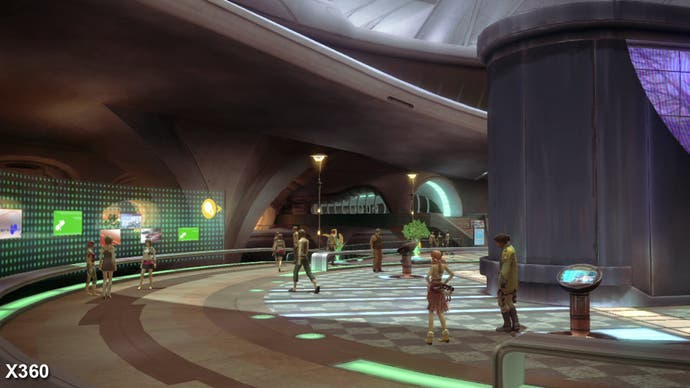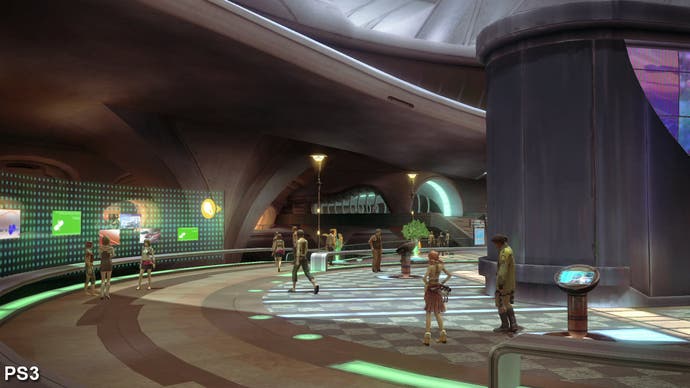Final Fantasy XIII: Endgame
Digital Foundry vs. FFXIII. The final analysis.
What is curious is the various tinkering under the bonnet that did go on in order to make the Xbox 360 version look a little better. Weirdly though, the effort only went into the very beginning of the game. FMV quality is massively improved on the title screen movie and the initial cinematic (you'll see why later on), and there is a case that texture filtering looks better on 360 in the first chapter too.


Let's be frank though, it's still not great (on either platform), and moving forward through the beginning, middle and end of the game it looks pretty much exactly the same cross-platform.




Some people took issue with our contention that the 360 version of the game could have been a lot better, pointing out that we weren't so generous with the PS3 port of Bayonetta. However, there are some obvious differences there. Like the whole basis of the game, for example. Bayonetta developer Platinum used all of the advantages of the 360 hardware: it exercised the eDRAM extensively, used texture compression systems simply not present in the RSX hardware, fully exercised the unified shader setup, used a lion's share of the system RAM, and pushed for 60FPS.
As we said in the original piece, for PS3 to replicate this would require extensive re-engineering - a data streaming system for overcoming the RAM shortfall. Platinum would need to parallelise a host of 360 GPU functions onto the SPUs. Set-piece and engine-driven cut-scenes could have exceeded the 360 counterparts by utilising BD space for streaming movies: instead the conversion-smiths were content on sub-par, lower frame-rate renditions.
As it is, the only perceivable PS3-specific work we saw came after the fact: an optional install for making the menu screens load faster. Bayonetta simply wasn't "portable", and it comes as little surprise to see that the new Platinum game, Vanquish, leads on PS3.
Comparatively speaking, the challenge for FFXIII was remarkably simpler. First of all, perhaps the biggest difference is the fact that - as far as we know - Square Enix handled the conversion itself. FFXIII 360 wasn't palmed off to a separate developer.
Secondly, converting back from PS3 to 360 is a lot more straightforward than vice-versa: the RAM deficit is automatically sorted by default, there's little the RSX solus can do that Xenos can't (FFXIII's HDR lighting was probably a bit of a headache though), and indeed, the best multiplatform games of the moment are designed with PS3 in mind simply because the process of mirroring development on 360 is simpler.
Take for example Battlefield: Bad Company 2. DICE optimised its code for PS3 and found that its setup for six SPUs worked similarly well with the six-thread Xenon CPU. 4A Games' new engine works on a similar principle, as does Burnout Paradise. In many cases, where the CPU is found to be weaker on 360 the GPU makes up the difference, or the differences themselves overall are marginal: Bad Company 2 performs slightly better on 360, Burnout Paradise runs a bit worse. Go mad on optimisations specific to one platform (Bayonetta, again) and things get sticky. However, mad usage of the Blu-ray apart, Square-Enix was relatively laid back in how it utilised PS3.
In terms of FFXIII, the graphics are a beautiful example of how the quality of the artwork and the post-processing effects make more of an impact on the overall look than the other technical aspects of the Crystal Tools engine (still known internally as the White Engine if the folder structure of the shipping disc itself is anything to go by).
Some areas are fairly low-poly, certainly the characters themselves, which concentrate detail on the head while the bodies of a comparatively modest detail. The corridor-like nature of most of the game also suggests that it shouldn't have been too difficult to port: geometry levels on many chapters don't look too arduous, high-quality 2D art in the background often takes the place of full 3D models, and even then, textures on 3D objects themselves are often fairly flat.
So with all those factors in mind, why should the Xbox 360 port be sub-HD? What happened?
With FFXIII, the overall impression is that what was done on the "second platform" came too little, too late with disappointing results - probably the one thing it does share in common with Bayonetta on PS3. The development team talked of developing four different engines, they talked of not even starting work on 360 until the PS3 game was complete, though that decision was seemingly reversed at some point.
Brutally speaking, what we have looks like a rush job. Bearing in mind that Square has developed Crystal Tools as the basis for its tentpole titles going forward, it will be interesting to see where they take the technology next, bearing in mind the important of the 360 in the Western market, and also factoring in that sales on the Microsoft console don't seem to have matched those of PS3: an unusual state of affairs for a cross-platform project.
However, the challenge for the Xbox 360 SKU that most captivated gamers was just how Square Enix would fare in converting across a game made for a dual-layer 50GB Blu-ray onto multiple DVDs. The linear nature of the vast majority of the quest took care of any potential disc-swapping issues, making it a logistical issue more than anything. How could 40GB of data be squeezed down to half the size? Clearly something had to be done about the colossal amount of space devoted to the video sequences.
In the original Face-Off we talked about video compression and how possibly the worst aspect of the 360 conversion was the truly horrible macroblocking. CG and cut-scenes that Square must have invested huge amounts of time and money into looked simply awful on 360. It's difficult to imagine that the original artists would ever have wanted their work to look like this.
The obvious conclusion to draw is that in shrinking down 32GB of movie footage to a mere 9GB, there is simply not enough room on the DVD system employed by Xbox 360, especially bearing in mind that only 6.8GB of the maximum 8.5GB of the dual layer DVD is available. This assumption relies on two facts: firstly that the compression is the best it can be, and secondly that 32GB is actually required to hit that picture quality. Both of those assumptions turn out to be false.








